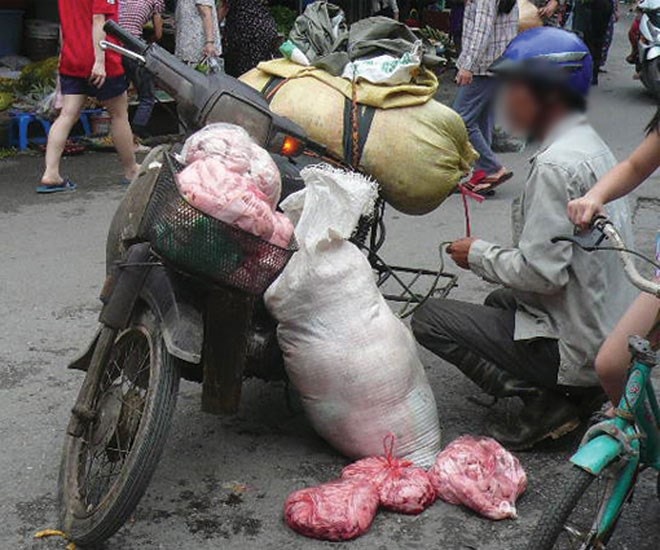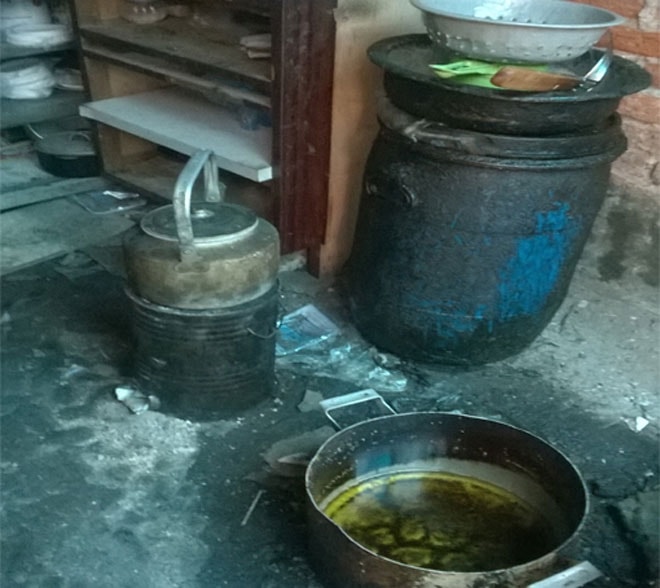Shocked "visit" to rotten fat processing plant
The squishy, crumbly, stinky pork fat collected from the market, without any preliminary processing or cleaning, is cut into 5-10cm pieces and put straight into the frying pan, then poured into plastic cans. The fat is stored in dirty, black baskets and basins and sold to people selling processed food.
 |
Buy waste and rancid fat from markets to make products.
Dirty fat processing industry
The production furnace of Mr. Do Van H (Tan Chau, Hung Yen) is a dilapidated, damp house, the surrounding furnace and the floor are black, slippery, slimy. Piles of pig skin, pork fat of all kinds are piled up on the ground in long blocks. On the stove, a large, concave-bottomed pan is frying boiling fat, next to it is a dirty fat container as if it has never been washed. The smell of fresh fat is too strong, the fat left for a few days turns into a foul, rotten smell mixed with the smell of finished fat and water, making you nauseous.
Mr. H and his mother (over 70 years old) quickly sorted. The flabby pieces of fat, the long ones, the broken ones, the ones with many defects, the ones with hairs were kept separately, the thick pieces of fat that had an unpleasant smell, and the ones with skin were kept in one place. The raw materials before and after sorting did not go through any preliminary processing or cleaning process but were cut into small pieces and put directly into the frying pan, except for some pieces with grit and a smell that had been there for a long time, which were rinsed with water hastily.
The processing is simple, just cut the fat into small pieces, put them in a pan, boil, fry to get the water, then filter the residue, let it cool, pour it into cans of all sizes, black and covered with dirt.
After chatting with the reporter, Mr. H shared about his work: “I personally go to many markets to buy pork fat. At the end of the market, the meat traders collect all the waste, unsold goods, stale goods, scraps, small items, and lumps, filter them out, weigh them, and I go over and they report the quantity and I pay. Many days I am busy and late, the meat stall owners throw the meat on the sidewalk and go home, I go over and pick it up and pay the next day. There are days when many stores have few goods and have to store them for a few days and weigh them once, so it is inevitable that the fat will smell rancid.”
The price of lard, leaf lard, scraps, and already smelly lard is 3,000 VND/kg, the thicker, “better quality” kind is 4,000-5,000 VND/kg. It is very easy to buy and readily available, meat traders compete to sell because instead of throwing it away, traders can earn a few tens of thousands from the scraps of lard.
Doing this job only requires hardship and dirt to make a living, the goods are easy to sell, the ingredients are cheap, the tools and processing are simple. Moreover, even though the fat is rancid and rotten, when fried into water, it is still fragrant, fatty and has a characteristic flavor, the fat is yellow and clear, the fried pork rinds are crispy and delicious.
 |
Small factory, big trust.
Small business, big achievements
Mr. H's small but profitable factory producing waste and rancid lard is popular with many restaurants. In addition, the factory is located far from home, so few people pay attention or know about it, except for business contacts.
Currently, the furnace produces 50-60kg of liquid lard and pork rinds every day. Mr. H buys the lard used for processing every market closing time. The lard processing usually takes place in the early afternoon. 1kg of lard, shredded lard, spoiled meat, and flaky meat will yield 4-5 ounces of liquid lard. In one working day, the furnace processes about 10-15kg.
Mr. H's customers are cheap rice shops, shops selling processed foods, onion frying ovens, fried dough sticks, cakes... and even restaurants and beer bars use this type of lard. The lard costs 16,000 - 18,000 VND/kg; the pork rinds cost 50,000 - 60,000 VND/kg. Compared to the price of raw materials after processing, the money earned from lard products is "one capital, four profits".
“Using cooking oil to cook food is not as delicious as lard and the cost is several times more. Using lard for frying is much hotter and the food is more delicious and fatty. Lard and pork crackling sell very well, they sell out as soon as they are made, there are even days when there is no product to return to customers, especially in winter. People who make rice and ready-to-eat food buy pork cracklings to wrap in spring rolls, sausages, etc., which is very profitable,” Mr. H enthusiastically analyzed.
According to Labor
